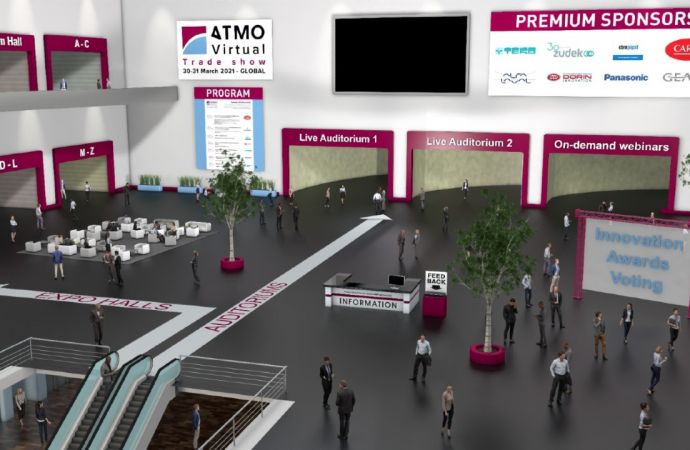Session 7 of day three of the 10th Gustav Lorentzen conference in Delft, Netherlands discussed new and upcoming applications for ammonia including ammonia heat pumps for household space and water heating, packaged ammonia chillers for industrial application, as well as means to reducing ammonia chiller peak cooling capacity demand that typically leads to energy waste in office buildings.

Small ammonia heat pump with variable speed compressor, by Behzad A. Monfared and Björn Palm
In this study, Monfared and Palm first recall the main reasons why ammonia is still almost exclusively used in large industrial or commercial applications. They then report on additional tests they have carried out in continuation of two previous studies (Palm 2008, Monfared and Palm 2011) attempting to prove that ammonia can be also suitable in small applications.
The system used for the study was a small capacity water to water heat pump used for sanitary hot water production and space heating. During the tests, the system was designed to deliver about 7.2 kW at typical running conditions with evaporating/condensation temperature between - 5°C and + 5°C. The heat delivery level was set up at 60°C for sanitary hot water production, as this is the minimum temperature for sanitary hot water to avoid risks of legionella, and at 40°C for space heating.
The new results were encouraging, as they helped to locate where efficiencies and losses of the system were most significant and they showed favorable performance of the heat pump for speed higher than 800 rpm.
The heating capacity and compact design of the system make it suitable for space heating and tap water heating in private households. As a next step, the two researchers will analyse further the results and conduct more experiments in different working conditions to identify ways to improve the system's coefficient of performance (COP).
Industrial chillers with ammonia as refrigerant: an end-user perspective, René van Gerwen and Subhankar Raha
In the first part of their paper, authors van Gerwen and Raha discuss end users’ tendency to choose indirect refrigeration systems over direct systems as they enable to reduce the refrigerant charge in the system and thus, to reduce atmospheric emissions.
In the second part, the authors present results of a comparative study led by Unilever Engineering services and Jacobs engineering on the basis of chiller suppliers information. The study compared energy efficiency, and technical performances of a typical packaged ammonia and an HFC chiller and found the ammonia chiller as the most suitable system for industrial application.
Although with ammonia the equipment costs increased by 34% compared to the HFC chiller, the payback of extra equipment costs came within 3.2 years. The Total Equivalent Warming Impact (TEWI) was reduced by 13,3%, while the annual energy consumption by 11,8%. COP increased by 13%. As industrial chillers frequently have a long lifetime, the study also showed that the ammonia chiller’s cumulative life cycle costs of ownership over 20 years was reduced by 7,9%.
The authors conclude by noting that although ammonia has already a long tradition as refrigerant in industrial process and cold storage refrigeration, the chiller community is still unfamiliar with NH3: 'More standardisation in equipment and housing, simplified operation, maintenance and safety management and lower equipment costs may further help in accelerating the wider use of the natural refrigerant ammonia in this new application area.'
Combining the use of thermal storage and indirect evaporative cooling to minimise the installed chiller capacity, by Gert Nielsen
In his paper, Gert Nielsen focuses on how to reduce ammonia chiller high peak cooling capacity demands, traditionally leading to energy waste in office buildings.
Using as reference a 17,000 m2 building located in Oslo, Norway with a nominal comfort cooling capacity demand of 761 kW, Nielsen assesses two chiller capacity reduction methods: Indirect evaporative cooling (IEC) & Thermal energy storage (TES).
It appears that solutions combining both methods are the most efficient and cost effective. In Nielsen’s example, the cooling demand was reduced from 761 kW to 391 kW thanks to indirect evaporative cooling and to 285 kW thanks to thermal storage capacity. Using both methods concurrently led to a reduced chiller capacity of 181 kW when swept volume target was 185 kW.
In this study, Monfared and Palm first recall the main reasons why ammonia is still almost exclusively used in large industrial or commercial applications. They then report on additional tests they have carried out in continuation of two previous studies (Palm 2008, Monfared and Palm 2011) attempting to prove that ammonia can be also suitable in small applications.
The system used for the study was a small capacity water to water heat pump used for sanitary hot water production and space heating. During the tests, the system was designed to deliver about 7.2 kW at typical running conditions with evaporating/condensation temperature between - 5°C and + 5°C. The heat delivery level was set up at 60°C for sanitary hot water production, as this is the minimum temperature for sanitary hot water to avoid risks of legionella, and at 40°C for space heating.
The new results were encouraging, as they helped to locate where efficiencies and losses of the system were most significant and they showed favorable performance of the heat pump for speed higher than 800 rpm.
The heating capacity and compact design of the system make it suitable for space heating and tap water heating in private households. As a next step, the two researchers will analyse further the results and conduct more experiments in different working conditions to identify ways to improve the system's coefficient of performance (COP).
Industrial chillers with ammonia as refrigerant: an end-user perspective, René van Gerwen and Subhankar Raha
In the first part of their paper, authors van Gerwen and Raha discuss end users’ tendency to choose indirect refrigeration systems over direct systems as they enable to reduce the refrigerant charge in the system and thus, to reduce atmospheric emissions.
In the second part, the authors present results of a comparative study led by Unilever Engineering services and Jacobs engineering on the basis of chiller suppliers information. The study compared energy efficiency, and technical performances of a typical packaged ammonia and an HFC chiller and found the ammonia chiller as the most suitable system for industrial application.
Although with ammonia the equipment costs increased by 34% compared to the HFC chiller, the payback of extra equipment costs came within 3.2 years. The Total Equivalent Warming Impact (TEWI) was reduced by 13,3%, while the annual energy consumption by 11,8%. COP increased by 13%. As industrial chillers frequently have a long lifetime, the study also showed that the ammonia chiller’s cumulative life cycle costs of ownership over 20 years was reduced by 7,9%.
The authors conclude by noting that although ammonia has already a long tradition as refrigerant in industrial process and cold storage refrigeration, the chiller community is still unfamiliar with NH3: 'More standardisation in equipment and housing, simplified operation, maintenance and safety management and lower equipment costs may further help in accelerating the wider use of the natural refrigerant ammonia in this new application area.'
Combining the use of thermal storage and indirect evaporative cooling to minimise the installed chiller capacity, by Gert Nielsen
In his paper, Gert Nielsen focuses on how to reduce ammonia chiller high peak cooling capacity demands, traditionally leading to energy waste in office buildings.
Using as reference a 17,000 m2 building located in Oslo, Norway with a nominal comfort cooling capacity demand of 761 kW, Nielsen assesses two chiller capacity reduction methods: Indirect evaporative cooling (IEC) & Thermal energy storage (TES).
It appears that solutions combining both methods are the most efficient and cost effective. In Nielsen’s example, the cooling demand was reduced from 761 kW to 391 kW thanks to indirect evaporative cooling and to 285 kW thanks to thermal storage capacity. Using both methods concurrently led to a reduced chiller capacity of 181 kW when swept volume target was 185 kW.
MORE INFORMATION
Related stories



